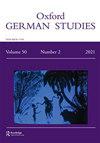救什么?伊莱亚斯·坎尼的舌音变奏曲
IF 0.1
3区 文学
0 LITERATURE, GERMAN, DUTCH, SCANDINAVIAN
引用次数: 0
摘要
卡内蒂的自传《释放舌头》不仅记录了他的童年,也是一本关于语言和死亡的书。它以卡内蒂的第一个视觉记忆开场:每天都有一个男人威胁说,如果他告诉任何人他和男孩的保姆的婚外情,就割掉他的舌头。男孩闭上了嘴,保住了舌头。在这里,舌头代表语言——正如作者后来所说,这是一种手段,通过它他甚至可以逃避死亡的力量。在卡内蒂的文化人类学著作《人群与权力》中,最黑暗的事件发生在口腔的微观世界中。这些都是消耗和整合外来物质的行为,卡内蒂在其中看到了所有权力过程的起源。在卡内蒂看来,嘴、喉咙和牙齿是权力的工具,而不是语言,因为它们制定了外来元素的同化、消化和无效。舌头在哪里?本文考察了卡内蒂思想中的这一空白,从解剖学和象征意义上把舌头定位在说话与吃饭、自我与世界、包容与排斥、生与死之间的不稳定地带。*《伊莱亚斯·卡内蒂自传》,《文学著作》,《文学著作》,《文学著作》,《文学著作》,《文学著作》,《现代文学著作》。研究结果表明:1 .研究结果表明:1 .研究结果表明:1 .研究结果表明:1 .研究结果表明:1 .研究结果表明:1 .研究结果表明:1 .研究结果表明:1 .研究结果表明:1 .研究结果表明:“善良的人”是“蒙德的人”和“尊格的人”。Die Zunge stete hier f本文章由计算机程序翻译,如有差异,请以英文原文为准。
Wozu Gerettet? Die Zungenvariationen bei Elias Canetti
Canetti’s volume of autobiography The Tongue Set Free not only documents his childhood it is also a book about language and death. It opens with Canetti’s first visual memory: each day a man threatens to cut out his tongue if he tells anyone about the man’s affair with the boy’s nanny. The boy kept his mouth shut and his tongue was saved. Here the tongue stands for language — which as the author later claims is a means through which he can evade even the power of death. In Canetti’s work of cultural anthropology Crowds and Power the darkest events take place in the microcosm of the oral cavity. These are the actions of consuming and incorporating extraneous matter, in which Canetti sees the origins of all power processes. In Canetti’s view, mouth, throat and teeth are instruments of power rather than speech as they enact the assimilation, digestion and nullification of outside elements. Where does this leave the tongue? This article investigates this gap in Canetti’s thinking, locating the tongue anatomically and symbolically in an unstable zone between speaking and eating, self and world, inclusion and exclusion, life and death. * Die autobiographische Schrift Die gerettete Zunge von Elias Canetti ist nicht nur ein Dokument über die Kindheitsjahre des Autors, sondern auch eine Geschichte über Sprache und Tod. Das Buch wird mit Canettis frühestem Erinnerungsbild eröffnet: Täglich droht ein Mann, dem kleinen Jungen Canetti die Zunge abzuschneiden, wenn er die Liebschaft zwischen ihm und dem Kindermädchen verraten sollte. Das Kind hielt den Mund und die Zunge wurde gerettet. Die Zunge steht hier für die Sprache — ein Mittel, mit dem, wie der Autor später behauptet, er sich sogar der Macht des Todes entziehen könne. In Canettis kulturanthropologischer Studie Masse und Macht vollzieht sich gerade im Mikrokosmos der Mundhöhle das Dunkelste: die Vorgänge der Verzehrung und Einverleibung, in denen Canetti die Ursprünge aller Machtprozesse sieht. Nach Canetti bilden Mund, Schlund und Zähne nicht primär Teile des Sprechapparats, sondern vielmehr das Instrumentarium der Macht, mit dem man sich das Fremde aneignet, es verdaut und annulliert. Und wo bleibt dabei die Zunge? Entlang dieser offensichtlichen Lücke in Canettis Überlegungen über Macht bewegen sich die Fragen des Vortrags, nach der anatomischen und symbolischen Verortung der Zunge bei Canetti in einer changierenden Zone zwischen Sprechen und Essen, Selbst und Welt, Inklusion und Exklusion, Leben und Tod.
求助全文
通过发布文献求助,成功后即可免费获取论文全文。
去求助
来源期刊

OXFORD GERMAN STUDIES
LITERATURE, GERMAN, DUTCH, SCANDINAVIAN-
CiteScore
0.10
自引率
50.00%
发文量
2
期刊介绍:
Oxford German Studies is a fully refereed journal, and publishes in English and German, aiming to present contributions from all countries and to represent as wide a range of topics and approaches throughout German studies as can be achieved. The thematic coverage of the journal continues to be based on an inclusive conception of German studies, centred on the study of German literature from the Middle Ages to the present, but extending a warm welcome to interdisciplinary and comparative topics, and to contributions from neighbouring areas such as language study and linguistics, history, philosophy, sociology, music, and art history. The editors are literary scholars, but seek advice from specialists in other areas as appropriate.
 求助内容:
求助内容: 应助结果提醒方式:
应助结果提醒方式:


